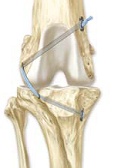Advanced Care - The Tightrope Surgical Procedure

One of the most common knee injuries in dogs is the rupture of the cranial cruciate ligament (CCL).
For dogs over 40lbs, the most common method of treatment by many veterinary surgeons is a procedure called a TPLO. This involves cutting the tibia bone and applying a bone plate to stabilize the CCL-deficient knee in these dogs. Now, a new minimally invasive technique option exists called the Tightrope procedure. This relatively new procedure has fewer and less severe complications than other surgical options. It has been developed by an orthopedic surgeon at the University of Missouri College of Veterinary Medicine. At Beechnut Animal Hospital, Dr. Matt has been performing Tightrope surgeries since 2007. Later, Dr. Matt became an instructor for Arthrex, the company that developed the Tightrope, and taught the procedure to veterinarians throughout the United States for a three-year period beginning in 2012.
The Tightrope technique is a modification of human procedures used in ankle surgery. A device is surgically placed that stabilizes the CCL-deficient knee through bone tunnels drilled using smaller incisions.
This new technique has the added advantage of being 1/2 the cost of the traditional TPLO. In published studies, dogs experienced fewer and less severe complications than with TPLOs. These same studies show outcomes equal to those seen with the TPLO.
Beechnut Animal Hospital has been one of the first veterinary hospitals in Houston to provide this procedure and have been doing so ever since 2018. Results have been excellent. Most dogs begin to walk the day following the procedure.
There are some pets that are not good candidates for the Tightrope procedure. Extremely active dogs where owners are unable curtail post-operative activity and dogs with limb deformities may not be candidates for this technique. The rehabilitation period is often quicker than other Cruciate surgical options. Activity during the first 4 months is limited to leash walking.
For more information or to discuss your pet's current health needs, please contact us.

